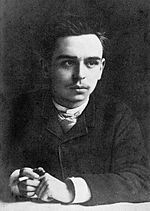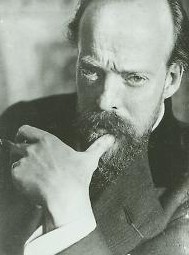| V. | Title | Scoring | Date | Notes |
|---|
By date: |
| 57 | Sonata in D minor | violin, piano | 1885 | unfinished, manuscript (marked "Opus 3") |
| 44 | Choral, (À mon oncle Pierre Lekeu) | violin, piano | 1885/6-7 | Opus 3 |
| 113 | Lamento | violin | 1886/11 | |
| 93 | Andantino semplice, (Andantino semplice e molto espressivo) | piano | 1887/6/22 | |
| 76 | Les Deux bonnes sœurs | voice, piano | 1887/8 | Text: Charles Baudelaire; lost |
| 78 | Lied de matelot | voice, piano | 1887/8 | lost; completed but a manuscript of an unfinished sketch exists |
| 77 | La Fenêtre de la maison paternelle | mezzo-soprano, piano | 1887/8 | Text: Alphonse de Lamartine |
| – | Invocation à Mallarmé | voice, piano | 1887/summer | Text: Stéphane Mallarmé |
| 80 | Les Pavots | tenor/baritone, piano | 1887/9 | Text: Alphonse de Lamartine |
| 48 | Méditation for string quartet, in G major | 2 violins, viola, cello | 1887/8-9 | intended as 2nd mvt of a string quartet, but the other mvts never written |
| 63 | String Quartet in D minor - 1st mvt
- Adagio
- Canzonetta
- Finale
| 2 violins, viola, cello | 1887/8-9 | lost; mvts 1-3 completed, 4th mvt unknown, a manuscript of sketches exists |
| 49 | Menuet | 2 violins, viola, cello | 1887/9 | |
| 52 | Mon âme est triste jusq'à la mort (My soul is sad unto death): Molto adagio, (Molto adagio sempre cantate e doloroso) | 2 violins, viola, cello | 1887/10/26 | Preface to a Quartet on phrases from the Bible |
| 84 | Adagio religioso, (Adagio religioso col piu grand' espressione) | piano | 1887 | |
| 106 | Tempo di Mazurka | piano | 1887/10 | |
99
96
102
100 | Morceaux égoïstes Set 1 - Lamento
- Chant pastorale
- Moderato poco allegro
- Lento doloroso
| piano | 1887/9
1887/10/20
1887/11
1887/11/26 | #1 & #2 lost |
| 58 | Quatuor contrapuntique | 2 violins, viola, cello | 1887/8-11 | planned, sketches? |
| 95 | Berceuse et Valse (pot-pourri) | piano | 1887 | |
| 71 | Prélude, Andantino and Tarentelle | cello, piano | 1887 | written for the cellist Gillet; lost |
| 66 | Thema con variazioni | violin, viola, cello | 1888/2/1 | |
| 33 | Adagio molto espressivo | 2 violins, piano | 1888/2 | |
| 60 | Quatuor (String Quartet), in G major - Allegretto quasi allegro
- Adagio sostenuto
- Capriccio
- Romance
- Poco allegro e molto scherzoso
- Final
| 2 violins, viola, cello | 1888/2/15 | |
| 50 | Minuetto | 2 violins | 1888/2/18 | |
| 65 | Sonate (Cello Sonata), in F major - Le cœuer plein des songes funèbres (The heart full of funeral dreams): Adagio malinconico
- It is both bitter and sweet during winter nights: Allegro molto quasi presto
- Mater suspiriorum: Lento assai
- You have caused me to prefer the sorrows of the night to the splendours of the day: Épilogue
| cello, piano | 1888/3 | last few pages of last mvt are lost (though possibly it was unfinished); completed by Vincent d'Indy 1923 |
| 38 | Vouloir: Andante più tosto adagio | violin, piano | 1888/4/23 | |
85
88
91
86
87 | Morceaux égoïstes Set 2 - Allegro marcato
- Andante in F major
- Andantino malinconico, a tre voci
- Andante in A minor
- Andante
| piano | 1887/11/27
1887/12
1888/1/4
1888/1/10
1888/5/17 | |
| 31 | Prèlude pour le troisième acte de Phèdre | orchestra | 1888/9 | Text: Victor Hugo; piano reduction; lost? |
| 2 | Scene from Les Burgraves | contralto, tenor, orchestra | 1888/11 | Text: Victor Hugo; orchestra in a piano reduction, unknown whether it was ever orchestrated; themes later reused in orchestral work Burgraves |
| 92 | Morceau: Andante sostenuto | piano 4-hands | 1889 | a fantasia on a Cramignon or Walloon folk dance melody |
| 41 | Canon | 2 violins | 1889 | |
| 119 | Étude de fugue | | 1889 | |
| 27 | Introduction symphonique aux Burgraves, (Overture after Victor Hugo's Les Burgraves) - Première partie: Modéré, très solennel
- Seconde partie
- Troisième partie
| orchestra | 1889/4/16 | the date is that of the 3 mvt sketch, before orchestration; the 3rd mvt was discarded and never orchestrated |
| 103 | Moderato quasi largo | piano | 1889/spring | |
| 127 | Poème de religion | orchestra | 1889/9 | projected, never written? |
| – | (unknown title) | chorus, orchestra | 1889/9/30 | written at the request of Professor Alphonse Voncken, director of the Société Royal de l'Emulation in Verviers; lost |
| 1 | Barberine, opera | opera | 1889/12 | sketches, abandoned; Prélude au 2e acte completed (c.f.); themes of other sketches later used in Chant de triomphale délivrance |
| 14 | Barberine, Prélude, (Prélude au 2e acte) (Prelude to Act II of the abandoned opera Barberine) | orchestra | 1889/12 | |
| 81 | Quelque antique et lente danse | soprano, piano | 1889/12 | Text: Lekeu |
| 79 | L'ombre plus dense | tenor, piano | 1889/12 | Text: Lekeu |
| 18 | Chant de triomphale délivrance, Étude symphonique, (Première Étude symphonique) | orchestra | 1889/12–1890/early | |
| 23 | Fantaisie contrapuntique sur un cramignon liégeois (Contrapuntal fantasy on the Liège Cramignon) | chamber orchestra | 1890/3/23 | with choreography for the individual musicians |
19
21
129 | Hamlet, Étude symphonique, (Deuxième Étude symphonique), (Hamlet et Ophélie) - Première partie: Hamlet
- Seconde partie: Ophélie
- Troisième partie: Marche funèbre
| orchestra; 3rd movement for chorus, orchestra | 1890/8/15 | 3rd movement never written; 2nd movement later revised with a different ending (c.f.) |
| 22 | Ophélie | orchestra | 1890/8/22 | revised version of 2nd movement of Hamlet, with a different ending intended to lead into the 3rd movement. |
| 70 | Trio pour piano, violon et violoncelle, (Trio à clavier) (Piano Trio), in C minor - Lent
- Très lent
- Très animé
- Lent
| piano, violin, cello | 1889/12–1891/1/7 | |
| 105 | Sonate (Piano Sonata), in G minor - (Prélude)
- (Fugue 1)
- (Fugue 2)
- Dans un mouvement plus lent
- Finale
| piano | 1891/2-3 | |
| 13 | Les fleurs pâles du souvenir, Adagio pour quatuor d'orchestre | string orchestra (with violin solo) | 1891/4/28 | published as Opus 3; arrangement of string trio Adagio? |
| 35 | Adagio | violin, viola, cello | 1891 | arrangement of a fragment of the string orchestra Adagio? |
| 17 | Épithalame | organ, ensemble (orchestra of strings, 3 trombones) | 1891/4 | |
| 73 | Chanson de Mai | tenor/baritone, piano | 1891/spring | Text: Jean Lekeu |
| 7 | Chant lyrique | chorus, orchestra | 1891/6 | Text: Alphonse de Lamartine |
| 3 | Andromède, Poème lyrique et symphonique, Cantata, 2 acts | soprano, tenor, baritone, and bass soloists, chorus, orchestra | 1891/8 | Text: Jules Sauvenière; composed for the Prix de Rome (Belgium) |
| 28 | Larghetto | cello, ensemble (orchestra of strings, 2 horns, bassoon) | 1892/2/3 | |
| 26 | Introduction et Adagio pour tuba et orchestre d'harmonie | tuba, wind orchestra | c.1892/2 | |
| – | Overture and Adagio | brass band | 1892 | arrangement of tuba/winds Introduction et Adagio? |
| 5 | Plainte d'Andromède | soprano, piano, 2 violins, viola, cello, doublebass | 1892/2 | arrangement of fragments of the choral/orchestral work |
| 132 | Paysage d'Ardenne | violin, orchestra | 1892 | planned, never written? |
| 130 | La Conquête du bonheur | vocal | 1892 | Text: Lekeu; planned, never written? |
| 107 | 3 Pièces- Chansonette sans paroles
- Valse oubliée
- Danse joyeuse
| piano | 1892 | |
| 25 | Fantaisie sur deux airs populaires angevins (Fantasy on two Angers folktunes) | orchestra | 1892/5 | |
| – | Fantaisie sur deux airs populaires angevins | piano 4-hands | 1892/5 | reduction of orchestra work |
| 64 | Sonate pour piano et violin (Violin Sonata) in G major - Très modéré
- Très lent
- Très animé
| violin, piano | 1892/7 | further corrections made up to 1893/2 |
| 83 | Nocturne | mezzo-soprano, piano, 2 violins, viola, cello | 1892/11/17 | arrangement of No. 3 of Trois Poèmes |
| 94 | Berceuse | piano | 1892/11/22 | |
| 82 | Trois Poèmes- Sur une tombe
- Ronde
- Nocturne
| soprano/baritone, piano | 1892/4/7–1892/12/13 | Texts: Lekeu |
| – | Trois Poèmes | soprano (unaccompanied) | 1892 | arrangement of the soprano/piano work |
| 133 | La Légende éternelle | | 1892? | planned, never written |
| 62 | Quatuor a clavier (Piano Quartet) in B minor - Dans un emportement douloureux (très animé)
- Lent et passionné
| piano, violin, viola, cello | 1892/12/3–1894/1 | 1st mvt finished 1893/7/16, 2nd mvt unfinished; completed by Vincent d'Indy |
By genre:
Scenic |
Vocal with orchestral accompaniment |
Orchestral |
Chamber music |
Songs |
Piano |
Sketches: |
Exercises: |
Planned: |









